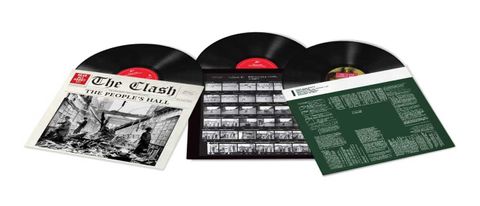Created tortuously against internal pressures, The Clash’s fifth album ironically proved to be their most successful, flying biggest hits amid its post-Vietnam fever-dream tone poems and New York street clamour.
The intra-band cracks showing while recording Sandinista! had widened by rehearsals for its follow-up at London’s Ear studios. Joe Strummer urged returning to basics, against Mick Jones’s continuing hip-hop obsession when sessions commenced at NY’s Electric Lady, Topper Headon sinking deeper into heroin addiction. The state of The Clash then glowers from Pennie Smith’s cover shot: Jones and Simonon distracted, Headon wasted, Strummer part-covering his face.
Yet magic still happened in the studio, luminescent mini-movies Straight To Hell and Sean Flynn reflecting their Vietnam war obsession on hallucinogenic jungle slowboats, Ghetto Defendant addressing inner-city drug-scapes with poet Allen Ginsberg. New York street energy charged Know Your Rights and Overpowered By Funk, before baroque finale Death Is A Star addressed cinematic escapism.
Recently deceased mentor Guy Stevens got credited with “Inspiration” on Combat Rock’s cover, notably Jones’s block-rocking future chart-topper Should I Stay Or Should IGo. Headon’s multi-instrumental overdubs culminated in Rock The Casbah providing another huge hit before his sacking in ’82. Jones’s Rat Patrol From Fort Bragg mixes became legendary after the band overruled his expansive visions, manager Bernie Rhodes hiring Glyn Johns to panel-beat it into a commercially-leaning single album.
The People’s Hall bonus disc adds early Radio Clash and Know Your Rights versions, B-sides and curios including racy out-take instrumental He Who Dares Or Is Tired and Outside Bonds acknowledging 1981’s NY-conquering residency with field-recorded street sounds.
Futura 2000 draws from sessions with NYC’s graffiti artist of the same name, Mikey Dread’s Radio One dates from Sandinista!. Rat Patrol-derived tracks include B-sides First Night Back In London and Long Time Jerk, Studio 54-inspired The Fulham Connection (The Beautiful People Are Ugly Too) and Idle In Kangaroo Court (Kill Time).
Lost until 1999’s Clash On Broadway, Midnight To Stevens reappears as their heartfelt eulogy to the fallen producer. The original Sean Flynn, breathing extra heady magic suggests further Rat Patrol nuggets – and, therefore, a more widescreen picture. Ultimately, however, this magnificent set is a vital snapshot of The Clash’s glorious last stand; on triple vinyl!


